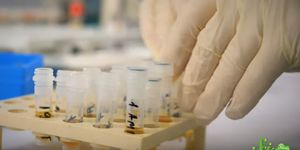The human body is made of many different kinds of cells, which can often be cultured in a lab and studied. However, those lab cultures often used to consist of a colony of cells growing in a layer in a dish, which is much different from the three-dimensional environment they have in the human body. Other research models may be more true to life in some ways, but involve animals, not humans. Organoids were developed to try to improve on the cell culture model; scientists created methods to use stem cells to direct the development of miniature, simplified versions of human organs in culture.
Organoids don't only provide a way to study biology, they also enable scientists to evaluate the impacts of drugs, and may open up new avenues to generating organs that could be used for patients in need. There are still significant technical hurdles, however, and researchers are continuing to improve on current organoid models that have longer lifespans and shapes that are more physiologically relevant.
Reporting in Nature, scientists have now used stem cells to generate an intestinal organoid that more closely resembles the real thing. Stem cells will organize along a tube-shaped scaffold that mimics real tissue, and researchers placed this type of scaffold in a microfluidic chip. In this work, the scientists embedded the tube scaffold into a hydrogel to provide an environment in which the stem cells could grow and get support.
It only took hours for the stem cells to spread through this scaffold, making a cell layer that had crypts and villus-like portions as the gut would. They even knew how to arrange like gut cells do.
"It looks like the geometry of the hydrogel scaffold, with its crypt-shaped cavities, directly influences the behavior of the stem cells so that they are maintained in the cavities and differentiate in the areas outside, just like in the native tissue," said the study leader Matthias Lütolf at EPFL's Institute of Bioengineering. The stem cells didn't just adopt to the shape of the scaffold, they produced all the key differentiated cell types found in the real gut, with some rare and specialized cell types normally not found in organoids.
"The introduction of a microfluidic system allowed us to efficiently perfuse these 'mini-guts' and establish a long-lived homeostatic organoid system in which cell birth and death are balanced," said the first study Mike Nikolaev.
The cells in the intestine turn over at a high rate. In previous organoid models, these cells would shed and build up, causing the organoids to break down.
These 'mini-guts' have a lot in common with the real thing; they can regenerate after damage and can model the interactions between host cells and microbes in ways that are new for organoids. This work may also help improve other types of organoids.
"Our work shows that tissue engineering can be used to control organoid development and build next-gen organoids with high physiological relevance, opening up exciting perspectives for disease modeling, drug discovery, diagnostics and regenerative medicine," added Lütolf.
Sources: AAAS/Eurekalert! via Ecole Polytechnique Fédérale de Lausanne (EPFL), Nature








